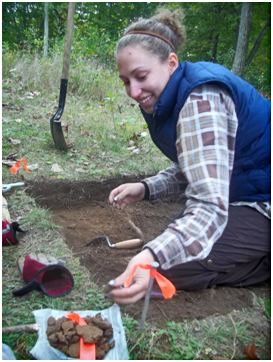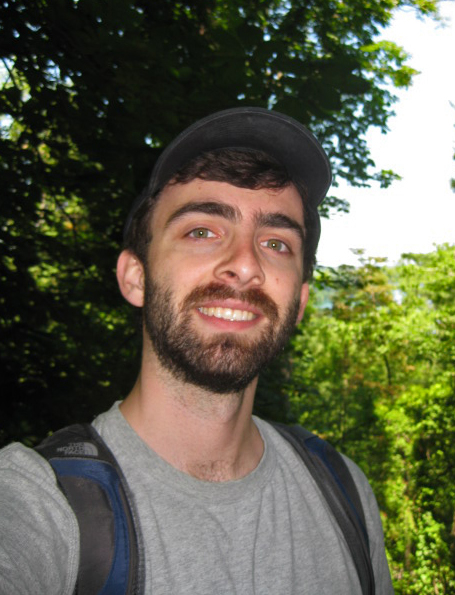Meet Scott and Amy. ASI has partnered with Borders in Globalization (BIG) to offer two internships to two highly-motivated students looking to research and explore concepts of boundary and territory as it pertains to archaeology and cultural heritage.
Amy St. John

My name is Amy St. John. I’ve been involved in various types of archaeological research since I earned my BA in combined Honours Classical Archaeology and Honours English at Wilfrid Laurier University in 2007, where I fell in love with archaeological fieldwork. I went on to complete my M.A. in Archaeology at Memorial University of Newfoundland in 2011, focused on interpreting ceramics from a migratory French Fishery site on Newfoundland’s North Shore, the Petit Nord. During this time I also worked in the archaeology laboratory at Memorial and supervised a field school lab, at Signal Hill National Historic Site. From 2011-2013, I worked steadily in field and lab settings of Cultural Resource Management archaeology firms in Ontario, both in technician and supervisory roles. I started my PhD in Anthropology at Western University in the fall of 2013. My ongoing PhD research explores the use of innovative non-destructive micro computed tomography (CT) technology, available at the Sustainable Archaeology facility at Western University, to examine the craft of indigenous ceramic manufacture. My PhD work will contribute to the larger ongoing research project on Late Woodland Borderlands directed by my supervisor, Neal Ferris.
When a friend told me about the intern position at ASI with the Borders in Globalization (BIG) initiative (http://www.biglobalization.org/) that focused on Pre-contact Boundaries of Indigenous Peoples in the Lower Great Lakes it seemed too good to be true.
As my current PhD research is focused on ceramic material from the Late Woodland Borderlands area, primarily from a cluster of sites of near Arkona, southern Ontario, notions about borders, boundaries and borderlands, both physical and conceptual, are something I’m rather interested in right now.
Guided by Ron Williamson at ASI, I am going to begin in August by reviewing interdisciplinary literature on territories and boundaries and address how various social scientists, archaeologists, anthropologists and Indigenous Peoples have defined “boundaries and territories” in the past and present. I will compile a comprehensive bibliography, refine these concepts and try to operationalize definitions of what is meant by “territory” and “social, cultural and political boundaries”. Once we become familiar with the ways researchers have framed notions of boundaries and territories in the wider literature we can narrow to the archaeological and historical records of the Lower Great Lakes and more closely examine one or two case studies (yet to be decided) to reconstruct shifting social, political and cultural boundaries in pre-contact Ontario. Over the course of 16 weeks we will produce research that will contribute to an academic paper/chapter providing culture historical background in one of the many books being planned as BIG project knowledge mobilization outputs. This research will also contribute to the body of archaeological knowledge in the Lower Great Lakes, and provide an innovative framework for thinking about the archaeological record of this region.
I’m very happy to have the opportunity to work with ASI and contribute to the large multidisciplinary BIG initiative. I’m looking forward to delving into the literature on borders, boundaries, frontiers, borderlands and territories. I appreciate the time Ron Williamson and Rob MacDonald at ASI and Neal Ferris at Western have spent with me to develop preliminary ideas for our proposal about what boundaries and territories might mean in the Pre-contact Lower Great Lakes and am excited to see where this research will take us.
Scott Cafarella
My name is Scott, and this summer I am working as a cultural heritage research intern with ASI and the Borders in Globalization Project. I am working closely with my advisors Joel Konrad and Rebecca Sciarra at ASI Heritage to develop a research project that will investigate the cultural heritage of the Niagara Escarpment.

My research explores strategies for assessing and managing cultural heritage landscapes and scenic views along the Niagara Escarpment.
Throughout Ontario’s history humans have lived and settled along the Niagara Escarpment, utilizing its physical resources and in turn creating a cultural landscape that is unique in North America. The Niagara Escarpment is an iconic landscape feature that crosses many jurisdictions in Ontario, and extends beyond Canada’s borders into Wisconsin and New York. The multi-jurisdictional nature of the Niagara Escarpment creates interesting challenges for its conservation as a continuous natural landform.
I sought out this internship because it afforded me the opportunity to further my understanding of the Niagara Escarpment, and the Escarpment’s role in Ontario’s history. Through this project I am applying my experience in Cultural Geography, Geographic Information Systems, and Landscape Architecture to the study of the Escarpment’s complex cultural landscape. Additionally, I am excited to be working with people from different disciplinary backgrounds (history, cultural heritage studies, geography, and archaeology) to explore the concept of ‘landscape’ and how it relates to our sense of place and belonging in the world. In the fall I will be returning to the University of Guelph to complete my graduate work in Landscape Architecture.


